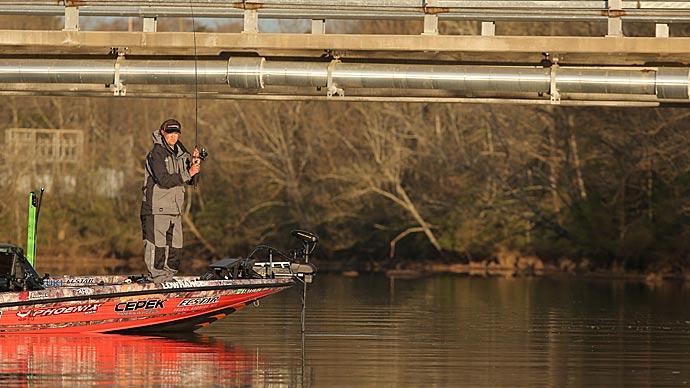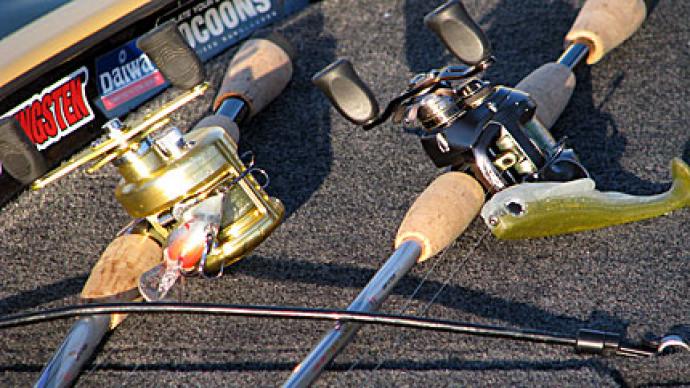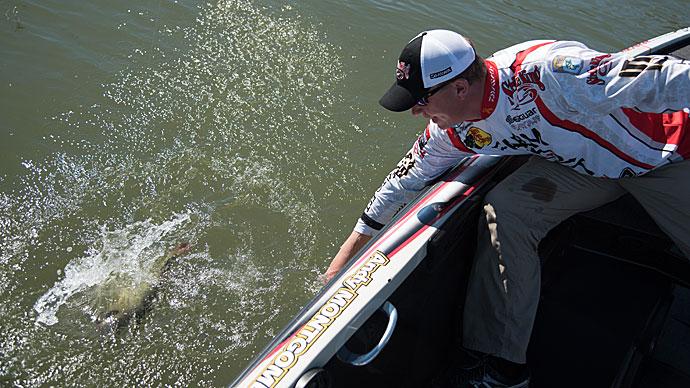| Crankbait Fishing tips |
| 1. Use a soft rod and a reel with a low gear ratio to prevent snatching the bait away from a biting fish. Fiberglass rods are ideal, but if you use a graphite rod, make it a soft one with a lot of bend to it. 2. Line is crucial: the lighter the line, the deeper the bait will run. Use the lightest mono you can get away with. If you're fishing open water and rocks, you can use lighter line than you can if you're fishing around a lot of brush and weeds. 3. Stick to basic colors like shad and crawfish patterns. In low light, use darker colors. Fire Tiger is good everywhere. 4. Make the longest casts, and throw way past the structure you want to bump. You have to give the bait a chance to get deep, which will travel in a U-shaped path. 5. Keep your drag relatively loose and use your thumb to control the fish. A too-tight drag can make it easy for a big fish to tear loose. 6. Make sure the treble hooks are good quality and very sharp. You don't want a dull or bent hook to make you lose that hawg. 7. Re-tie often and check the crankbait for wear and tear. Wooden crankbaits can get cracks in the paint that will allow water to penetrate the lure. Once the wood gets soft, the entire body can pull off the bill. 8. When you feel the crankbait crash into something, stop reeling and let it float. Fish often bite when the bait starts to rise. 9. If possible, try out a new lure in a swimming pool to see how deep it runs on different line sizes. 10. Use Suspendots or Suspendstrips to make a lure run deeper. You can also wind the lead line around the hook shanks. 11. The longer the bill, the deeper the bait will run. But be prepared - fishing a deep-diving crankbait all day is hard work! |
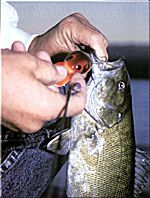
Professional anglers can locate and catch bass when others are frustrated. From lures to lines and rods to reels, they develop the equipment and methods that consistently produce quality fish, even under the worst conditions.
"It can be difficult to locate bass in late summer and early fall," says Procraft pro Jim Purr. "They're moving around a lot this time of year, and they can be almost anywhere." So instead of trying to find them, Furr makes sure the bass can find him - by using big, deep-diving crankbaits that crash against rocks and trees and raise a ruckus no self-respecting bass can ignore.
"Just about every crankbait made has a wobble to it," Furr says, "and a bass can feel the vibrations with its lateral line. That gets their attention, and when a bait bangs into something and bounces off, they don't think about it - they grab it and run. That noisy, erratic crashing and banging can get a bass fired up."
For the best in deep cranking, Furr looks for areas with easy transitions from deep to shallow water. "A submerged hump or reef can be just loaded with bass roaming around looking for something to eat. Long points, flats with good drop-offs, and creek channels that run down coves are also areas where I throw a crank. When choosing a bait, I go for the real deep-divers because I want them churning up mud on the bottom and banging the boulders.
"I always keep a crankbait tied on," says Furr. "I usually keep three crankbait rigs ready to go, able to cover a six-foot variance: cranks on lighter line, heavier line, and one on the lighter line with a few Suspendots. This provides options to reach that few extra critical feet of depth whenever needed."
Line size is crucial, and Furr became a firm believer with a story everyone can relate to. "I was fishing the same crankbait as this other guy once," Furr explains, "and he was catching the heck out of them, and I was getting nothing. I couldn't figure it out, and then I found out he was using 8-pound line, and I was throwing 14. That made all the difference."
Furr uses the lightest mono he feels he can get away with. If he's throwing his lure around a lot of submerged brush and weeds, he'll use heavier line; fishing open structure and rocks, he'll go lighter. But it's not just the line that gets beat up. "When you're crashing a crankbait around the rocks all day, the hooks take more of a beating than the line does," he says, "so I almost always change out the hooks on a crankbait before a tournament. I always put on Gamakatsu hooks, but I don't usually mess with the sizes - that's a little more scientific than I care to get!" When he's on a crankbait bite during a tournament, though, he changes the hooks every day.
"A big bass on a crankbait is a scary thing," continues Furr. "The way they leap around and thrash their big heads back and forth, you're certain they will come off. Then there's the question: do you want to risk putting your hand down there to try to lip the fish, or do you go ahead and get nine hook points tangled up in your net? Before you make that decision, make sure you've made the few others that you get to that point. I'm talking rods, reels, and line.
"Crankbaits are way too easy for a fish to throw. For example, a stiff rod or a tight drag can yank the bait right out of a fish's mouth. You need to give a little. Fiberglass rods are definitely the way to go, but along with the soft rod, you'll need a slow, powerful reel. I believe in crankbaiting with a low-speed reel, and plain old monofilament line is fine - save the expensive braids and fluorocarbons for something else. You want an outfit that will give the fish a chance to get its mouth around the crankbait and chomp down before starting to pull. I leave the drag set a bit light, but keep a thumb on the reel. I want to let the fish have the lure, so the light drag helps. But once the hooks are started, I clamp down with my thumb, so they dig right in. Then I just let the reel do the work.
"A reel with a lower gear ratio helps keep you cranking at the right speed, which is essential. Plus, crankbaits only run at their deepest for a short time during the retrieve. When they first hit the water, they must dive for a bit before reaching their maximum. They run at that depth until the line itself starts bringing them up. So the longer the cast, the longer the crankbait runs down deep. You don't need to reel fast to get the bait down, though - a medium retrieve does the best job - so don't overdo it.
"Once it's down there, keep reeling at a steady pace, but slow it down. You want to feel that bait crash into things fairly regularly, and when the lure does bang into something, stop reeling for a second and let the bait float up a bit - that's when a lot of big bites occur.
"If you're getting bit, but they're not getting hooked, you're probably fishing too fast. Often, if I notice the fish are just eating the back hook, I'll slow down or maybe change colors. But usually, the problem is a retrieve that's too fast. We fishermen tend to be in a hurry to catch fish all the time, and most of the time, the fish aren't in a hurry at all!"
That said, there is no magic speed, and Furr will mix it up throughout the day, especially if he's in deep enough water to use the graph and see fish. "At times, it's just the angle that makes the difference," he explains. "A fish will ignore a bait on one cast, then grab it on the next. Therefore, I do a lot of fan-casting over good areas - keeping the boat in one spot and casting the lure out at several different angles before moving the boat again. In the winter, it often pays to keep the boat in shallow water and fish the crankbait uphill.
"If I'm fishing deep and catch a good fish, I'll throw a buoy out and work all around that area at different angles. Usually, if you catch one good fish on a hump or a channel, there's more around. The key is to follow the fish. Once you discover the combination of depth and speed, follow the break lines and structure to catch more fish.
"In late summer and early fall, I usually find them along steeper drop-offs around flats. They come up early in the morning to eat, then go back down later in the day. With a deep-diving crankbait, I can follow them around and get them to grab before they think about it.
"Bluffs are great this time of year, too. The bass will lay up in crevices and overhangs where they can easily change depths. I get my boat up close to the wall and fish the crankbait parallel to the cliff. The fish will dart out and grab it as it goes by, especially if the bait makes noise or knocks against the rocks."
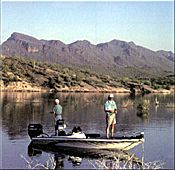
To get the bait into tight places, Furr offers a great tip. "If you take a pair of needlenose pliers and bend the tie-ring," he explains, "the crankbait will run toward the side it's bent to. You can use this trick to make the lure run up under overhanging trees or continuously crash into a wall when you're fishing it parallel. After you're done, bend the tie-ring back, re-tune the lure, or keep it reserved for similar circumstances."
Once he gets a fish on, Furr tries to fight it on a loose drag and lets it wear itself out. "Big fish can tear loose pretty quickly - that's why I rely more on thumb pressure than drag. In heavy sticks and stuff, about all you can do is keep the rod down and try not to let the fish jump.
"Another good tip is to always stop the bait right by the boat before swinging it in to recast," he says. "Smallmouths are especially good at hitting the bait at boat side, so if you see a fish following the bait, try to stop it for a second and let it float up. If that doesn't work, and you keep getting follows, try speeding up your retrieve just a bit to make them grab it before it 'gets away.'"
Weather also plays a factor. "If the wind is blowing, it seems to make the fish more active," says Furr. "In a good breeze, I sometimes switch to a Rat-L- Trap and speed up the retrieve. You can count a lipless crankbait down as deep as you like and fish it very fast."
Time of year, too, is essential. "In the fall, the fish will be in the same places you caught them in pre-spawn, but instead of moving in, they'll be moving out. I usually try places like points and channels that provide easy access to coves and flats, and I can cover them very quickly and thoroughly with a deep-diving crankbait."
Furr's right - crankbaits are incredibly versatile, and they're especially deadly in the waters we fish here in the West. Anytime you can work rocks and cranks into your repertoire, the outcome is bound to be good, and a deep-diving, bottom-banging, cliff-crashing crank is hard to beat. It allows you to fish both deep and shallow on the same cast, and you can cover everything from a flat to a bluff. Tie one on this fall and keep the net handy - you'll need it!
Reprinted with permission from Bass West Magazine


